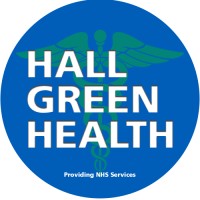
Bringing together communications for clinical and non-clinical staff and conducting CQC assessments with ease
Industry: Healthcare, NHS Trust
Company size: 100+ employees
Set up: Office based and off-site employees
Hall Green Health is part of the NHS Birmingham Cross City Clinical Commissioning Group (CCG). The main practice is located in a purpose-built health centre, which it shares with various services provided by Birmingham Community Health. The establishment is managed by a partnership of 15 GP partners and has a team of over 100 employees split between clinical and non-clinical (practice) staff. Most of its staff is office based with a small proportion working from home as part of post covid flexible work initiatives.
- Bringing together communications for clinical and non-clinical staff
- Meeting the ‘Leading from the top’ criteria by the Care Quality Commissioner (CQC)
- Increasing employee engagement and building a positive culture

Strategic Challenges
The surgery’s performance challenges centred around the visibility and standardisation of their performance management processes. Whilst the leadership team was confident that once-a-year appraisals were completed, there was little insight into quarterly reviews, which are designed to enable team members to succeed with their individual annual targets.
Different managers had different levels of experience conducting appraisals and reviews, which meant that they were completed in different ways and required a lot of preparation and effort from those who weren’t practised in performance management.
Another important consideration was the visibility of how individual goals and objectives fed back into organisational targets and their mission and values. Because appraisals and reviews were recorded on Word documents, the process was like a puzzle with separate pieces; all laid out on the table but not put together to display the full picture. So, employees couldn’t really see how their work contributed to the overall success of the company. To find out the details, managers had to ‘dip’ into several documents and read through pages and pages of information. This was time-consuming and inefficient from a strategic perspective.

Differences in communication preferences between clinical and non-clinical staff
The healthcare provider found that there was a big difference in communication styles of their clinical and non-clinical staff. Whilst e-mails worked well for the non-clinical team, they didn’t seem to resonate with their clinical employees. This posed challenges with reaching everybody within the organization. The leadership team regularly had to resort to memos, paper notes and verbal messages, just to ensure that everyone received any important information. However, there was no way of tracking who received what. When there were any records, it took a lot of time to pull them together. (For example, searching for e-mails and replies.)

Providing evidence for the Care Quality Commission (CQC) inspections was a challenge
The CQC monitors, inspects and regulates health services to make sure they meet fundamental standards of quality and safety. To achieve high ratings following a CQC assessment, healthcare providers must show evidence of being well lead and safeguarding.
‘Well-lead’ means evidencing that the surgery is leading from the top down. This closely links to communications and demonstrating that certain strategic messages are cascaded down efficiently. One important area of focus is safeguarding.
Safeguarding is about making sure that an organisation is run in a way that actively prevents harm, harassment, bullying, abuse, and neglect and has appropriate ways to deal with any problems. As such, the surgery must ensure that its staff understand what safeguarding is and how they can access any information in relation to the subject. Hall Green Health repeatedly sent reminders once a month to its team, but it was difficult to see who received, who read it and who needed to be reminded.

Solutions & Results
A ‘living’ system that guides users through performance management
With StaffCircle, Hall Green Health have a system in place that ‘talks’ its managers through the review and appraisal processes. Instead of having to concentrate on how to do an appraisal and what questions should be answered the software prompts you and provides you with pre-determined questions that are based on organisational objectives. By answering those questions, you are already doing the appraisal in a correct, standardised way. Objectives are visible at a very quick glance for everyone. This helps the Hall Green Health team provide evidence for the CQC.
There is now a provision in place to replace ‘once a year’, paper-based appraisals with regular check-ins and feedback, all aligned to objectives encouraging continuous development and strategic growth.

A central communication hub, with no barriers to access
Using different systems often means a variety of logins. StaffCircle acts as a central hub for both communications and performance management which means only one login and a holistic approach. The Hall Green team found paying for different systems more costly and it was also less likely that people would log into them all and use them.
StaffCircle’s communications feature allows the managers to target and select specific users, user groups and departments and tailor communication accordingly. This results in a more personalised approach and more relevant content. Even better, they now include videos, animations, surveys, and polls, which contribute to steadily increasing engagement levels within the practice since first implementing the software.
The surgery’s internal communication channel is split into three areas – ‘Main (default) Feed’, ‘Departmental Updates’, and ‘Positivity’ which includes positive feedback from work, positive feedback from non-work, food and social events (for after lockdown) to build the company culture. Within ‘Positivity’ the organization encourages its team to provide feedback, awards, and rewards to each other. These are recorded on individual profiles and staff can refer to them in their appraisals and reviews as part of their achievements. Whilst verbal feedback gets forgotten and e-mails get lost, StaffCircle ‘collects’ these interactions with the view of building employee engagement and an inclusive culture.
Easily accessible records and reports for CQC assessments
StaffCircle’s dashboards and reporting capabilities provide the leadership team with insight into who has read communications or interacted with content. The system can highlight low engagement which allows managers to tackle any issues before they take root. They can also re-target certain user groups to ensure that critical communication isn’t missed. So, when it comes to pulling information and evidence together for the CQC it is all in StaffCircle. There is clear visibility on what was sent, when it was sent and which user groups it was sent to. Managers can access the information with just a few clicks.
Although Hall Green Health is earlier on in their StaffCircle journey, the practice is already experiencing the above-outlined benefits that will just grow over time as the team starts using more & more features
Implementing StaffCircle means removing barriers to communication and having an easy way to record and display inportant data that we can use for our CQC audits. I also love the tasks feature, which I use for organising my daily workload
Jamal Syed, IT Manager




